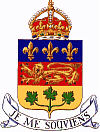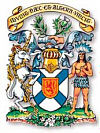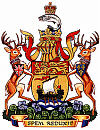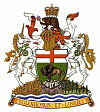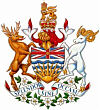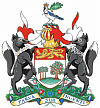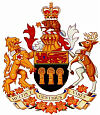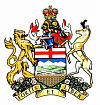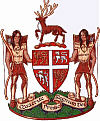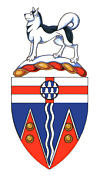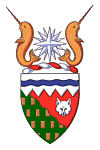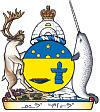Arms & Badges - Arms of Canada's Provinces and Territories
Canada's culture and traditions are well respresented in the armorial
bearings of the Provinces and Territories. From the historic arms of Nova
Scotia granted by Royal Warrant in 1625, to the newest grant of arms to
Nunavut in 1999, and including the most recent augmentation to the arms
of Prince Edward Island in 2002, civic heraldry in Canada continues to
offer a rich visual interpretation of regional identity.
|
||||||||||||||||||||||||||||||||||||||
|
ONTARIO: On May 26, 1868, the year following Confederation,
Ontario was granted arms within the new Dominion of Canada. The supporters,
crest, and motto, designed by Toronto barrister Edward Marion Chadwick,
were added on Feb 27, 1909 by Royal Warrant from King Edward VII. The
shield of arms consists of three gold maple leaves on a green background,
above which is a wide white band with a red St. George's cross. The
crest is a black bear standing on a gold and green wreath. The supporters
are a moose and a deer at the sides of the shield. Below the shield
is a scroll with the Latin motto. The maple leaves on the shield are
of course the symbol of Canada. The cross of St. George recalls the
historic connection with Britain in Upper Canada and pays tribute to
the namesake of the monarch, George III, while the black bear, moose,
and deer are indigenous to Ontario. Heraldic Description |
||||||||||||||||||||||||||||||||||||||
|
QUEBEC: As a founding province in Confederation, Quebec was
granted arms on May 26, 1868 by Royal Warrant. Design changes were made
in 1939 by the Quebec government to achieve the current armorial bearings,
which include the royal crown and a motto. The shield of arms is divided
into three horizontal fields: the first bearing three fleurs-de-lis
on a blue background; the second a gold lion on a red background; and
the third, three green maple leaves on a gold background. The shield
is surmounted by the royal crown and accompanied underneath by a silver
scroll bearing the motto in blue letters. The fleurs-de-lis symbolize
the orgins of Quebec as New France. The gold lion originates from the
royal arms, and the maple leaves symbolize the new land of Canada in
which are joined the traditions of royalist France and Britain. The
motto was authored by E. Tache, who used it in the architectural design
of the Quebec Legislative Buildings. |
||||||||||||||||||||||||||||||||||||||
|
NOVA SCOTIA: The ancient arms of Nova Scotia were granted to
the Royal Province of Nova Scotia (New Scotland) in 1625 by King Charles
I in support of the first British colonial effort on the Canadian mainland.
The shield displays a blue saltire (St Andrew's cross) -- the emblem
of Scotland -- upon a white or silver background (this is the reverse
of its use in Scotland). On the cross is a small shield bearing the
Royal Arms of Scotland. The royal helm (in gold, with the bars facing
the viewer) indicates sovereignty over the new colony. Above it is the
crest: two joined hands, one armoured and the other bare, supporting
a spray of laurel for peace and a thistle for Scotland. On the left
of the shield is the royal unicorn of Scotland and on the right a 17th-century
representation of a North American Indian. Entwined with the thistle
of Scotland at the base is the mayflower, floral emblem of Nova Scotia
which was added on January 19th, 1929 by Royal Warrant. The motto is
placed on a scroll above the achievement of arms, as is done for many
Scottish grants. Heraldic Description |
||||||||||||||||||||||||||||||||||||||
|
|
NEW BRUNSWICK: Arms were granted to New Brunswick by Royal Warrant on May 26th, 1868 as one of the founding provinces in the Dominion of Canada. These arms were based upon the first Great Seal of the province. The principal charge of the shield is an ancient galley, symbolizing the maritime province's links to the sea. Above is a gold lion on a red background, symbolizing England, as well as the family connection of the royal House of Hanover with the Duchy of Brunswick in Germany, after which the colony was named. The motto, 'Hope was restored', -- added in 1966 -- refers to the province's having acted as a haven for Loyalist refugees who fled there during and after the American Revolution. On September 25, 1984, to mark the province's bicentennial, the arms were augmented by Queen Elizabeth II with a crest, supporters and compartment. The crest, an Atlantic salmon leaping, arises from a coronet of maple leaves and bears a representation of the Royal Crown upon its back. The supporters are white-tailed deer wearing wampum collars, hanging from which are small shields, that on the left showing the "Union Jack" of Great Britain and that on the right the three fleurs-de-lis of Royal France. These commemorate the colonization of New Brunswick by the two countries.The compartment below the shield is adorned with purple violets -- the provincial flower -- and fiddlehead ferns. Heraldic Description |
|||||||||||||||||||||||||||||||||||||
|
MANITOBA: The arms of the Province of Manitoba were assigned by Royal Warrant of King Edward VII on May 10, 1905. The principal charge on the shield is a bison and above it the Cross of Saint George, a symbol of England. On October 23, 1992, Manitoba received an augmentation of arms from the Canadian Heraldic Authority during a special ceremony in the Legislative Assembly in Winnipeg. The grant celebrated Manitoba's heritage and 125 years of Confederation. Above the shield were added a gold helmet symbolizing Manitoba's co-sovereign status in Confederation, and upon it the crest: a beaver holding a prairie crocus (the Province's floral emblem), and upon its back the Royal Crown. The newly granted supporters were: on the left, a white unicorn -- derived from the Royal Arms -- which, being symbolic of Scotland, represents the early Scottish settlers of Manitoba. Around its neck is a collar from which hangs the wheel of one of the famous Red River carts. On the right of the shield is a white horse, an animal vital to the culture of the prairie-dwelling First Peoples, the Metis and the European settlers. Around its neck is a bead and bone collar, hanging from which is a First Nations symbol for the nature and meaning of our existence, the sacred cycle of life. The supporters and the shield rest on a base which depicts the grain fields and forests of Manitoba above the blue and white waters of its lakes and rivers. The scroll below bears the Latin version of the provincial motto, "Glorious and Free." Heraldic Description |
||||||||||||||||||||||||||||||||||||||
|
BRITISH COLUMBIA: The Arms and Motto of British Columbia were
granted by King Edward VII, March 31,1906. The augmentation of crest,
supporters and compartment were issued by Royal Warrant of Queen Elizabeth
II, on October 15th 1987, although the Province had assumed the same
supporters and a similar crest for many years previously. The shield
features a representation of the sun setting into the ocean, symbolizing
the province's location on the Pacific, and above it a Union Jack with
an antique crown at its centre, suggestive of the Province's name and
its strong connection with Britain. On top of the helmet is the Queen's
royal crest, a gold lion standing on all fours, facing the viewer and
wearing the royal crown. With Her Majesty's agreement, the Royal Crest
was granted for the first time in history to another sovereign entity
-- albeit with a mark of difference. The B.C. lion has an appropriate
differencing mark, wearing about his neck a garland of dogwood, the
provincial flower. The supporters are a wapiti stag and a bighorn sheep.
The wapiti of Vancouver Island and the bighorn sheep of the Mainland
symbolize the two separate colonies which united to form British Columbia
in 1866. To learn more about the armorial achievement of British Columbia
visit the website of the Government of British Columbia's Protocol
and Events Branch. Heraldic Description |
||||||||||||||||||||||||||||||||||||||
|
|
PRINCE EDWARD ISLAND: The arms of Prince Edward Island were
assigned by Royal Warrant on May 30th, 1905. The shield shows a large
oak tree on the right and three young saplings on the left. The mature
tree represents England, while the three saplings stand for the three
counties of Prince Edward Island. The upper section displays a gold
lion on a red background, derived from the arms of Prince Edward, Duke
of Kent, after whom the province was named in 1799, and also from the
arms of King Edward VII. All rise from the same foundation, symbolic
of England and the province as islands. On December 13, 2002, Her Excellency
Adrienne Clarkson, the Governor General of Canada, presented a full
achievement of arms to the Province, an augmentation to the original
1905 arms being granted by Vice-regal Warrant from the Canadian Heraldic
Authority (read
the Governor General's presentation speech). Above a golden helmet,
a symbol of co-sovereign status in Confederation, is a blue jay -- the
avian emblem of Prince Edward Island -- wearing a replica of the Royal
Crown of St. Edward, and in its beak a leaf from the red oak, the silvan
emblem of the province. On each side of the shield stands a silver fox.
The foxes represent the ranched-fur industry and further symbolize inspiration,
ingenuity and perseverance. Agriculture and fisheries are also represented,
since one fox wears a garland of potato blossoms around its neck and
the other, a length of fishing net. Below the shield is an eight-pointed
star of porcupine quill, a symbol used by Mi'kmaq people for centuries
to represent the sun. Around the star are other natural symbols of the
early settlers; the rose for England, the thistle for Scotland, the
shamrock for Ireland, the lily for France. The scroll reads PARVA SUB
INGENTI which was derived from the Great Seal of the Province and is
traditionally translated as 'The small under the protection of the great'.
To learn more about the armorial achievement of Prince Edward Island
visit the Government
of Prince Edward Island's website. |
|||||||||||||||||||||||||||||||||||||
|
SASKATCHEWAN: The arms of Saskatchewan were assigned by Royal Warrant on August 25th, 1906, one year after the Province was formed from the Districts previously known as Athabaska, Assiniboia, and Saskatchewan. The shield displays three gold wheat sheaves representing the importance of agriculture as the principal occupation and source of weath in the area. Above the wheat sheaves is a red lion, derived from the arms of the sovereign and those of the heir apparent, the Prince of Wales. The Prince of Wales is also the Earl of Chester and the arms of that earldom consist of three sheaves of wheat. By Royal Warrant in 1986, the Province was granted an augmentation to the arms consisting of a crest, supporters, and motto. Atop the Shield is the Royal Helm, red and white mantling and wreath. On the wreath is a beaver, a national symbol of Canada, holding in its right paw the official flower of Saskatchewan, the Western Red Lily. Above the beaver is the Royal Crown, representing Saskatchewan's co-sovereignty in Confederation. To the left of the shield is a gold Royal Lion and to the right a white-tailed deer, Saskatchewan's official animal. Both animals wear collars of Prairie Indian beadwork. Suspended from the lion's collar is a six-sided star bearing a red maple leaf, a national symbol of Canada. From the deer's collar hangs a similar star bearing a Western Red Lily, the official floral symbol of Saskatchewan. The Motto, MULTIS E GENTIBUS VIRES, means 'From Many Peoples Strength',. representing Saskatchewan's multicultural heritage, including Native contributions and the vital role immigration played in Saskatchewan's early history. The Motto scroll is also entwined with Western Red Lilies. Heraldic Description |
||||||||||||||||||||||||||||||||||||||
|
ALBERTA : On May 30th, 1907, arms were assigned by Royal Warrant to the Province of Alberta. Two years earlier, the Province had been formed from an area previously under the viceregal power of the Hudson's Bay Company. The shield displays the Cross of St. George in the chief to commemorate this association, the red cross on a white background being the principal charge in the arms of the Hudson's Bay Company. Below the cross is a pictorial representation of geographic features of the Province: a range of mountains, hills, and prairies all above a field of wheat. In celebration of the seventy-fifth anniversary of the Province of Alberta, an augmentation to the arms -- crest and supporters -- was issued by Royal Warrant from Her Majesty Queen Elizabeth II, on July 30th, 1980. Upon a helmet with a red and white wreath sits a beaver, supporting on his back a Royal Crown. The beaver is a national symbol of Canada and also recalls the role of the Hudson's Bay Company in the early exploration and governance of the region. The supporters, a gold lion and a pronghorn antelope, are standing on a grassy mount with wild roses, the official flower of the Province. For more information visit the Government of Alberta's website, Emblems. Heraldic Description |
||||||||||||||||||||||||||||||||||||||
|
NEWFOUNDLAND AND LABRADOR: Armorial bearings were assigned to
Newfoundland by letters patent under the seal of Sir John Borough, Garter
Principal King of Arms, on January 1st 1638. The red shield is divided
by a large white cross, bringing to mind the Arms of the Knights of
St. John, a possible connection to the founding of Newfoundland by John
Cabot on the day of that Order's patronal feast. The cross is also a
reversal in colour of England's cross of St. George. In the four quadrants
between the arms of the cross are alternating crowned gold lions and
white unicorns, chosen from the supporters of the British Royal Arms
borne since 1603. The letters patent call for an elk above the shield
as the crest, but elk are not native to the island and it is generally
accepted that the animal of the crest was meant to be a caribou. The
figures on each side of the shield are stylized depictions of the indigenous
people, the Beothuks, dressed and armed for war. The motto was taken
from St. Matthew's Gospel, "Seek ye first the Kingdom of God.". |
||||||||||||||||||||||||||||||||||||||
|
YUKON: The arms of the Yukon Territory were granted by royal
warrant from Queen Elizabeth II in 1956. The lower portion of the shield
is blue, divided vertically by a pair of wavy white lines representing
the Yukon River and the gold-bearing creeks of the Klondike. On either
side are stylized mountains charged with gold discs representing the
rich mineral resources of the Territory. The top portion of the shield
bears a cross of St. George, a reference to Britain and to the early
English explorers of the area. Placed at the centre of the cross is
a symbol of the fur trade - a circular figure with a blue-and white
pattern known as vair (vair being an heraldic term for fur). Above the
shield and the gold-and-red wreath is a Malamute (Husky) dog standing
on a mound of snow. From the earliest days of exploration, the strong
and quick Malamute played an important role in opening up the Territory
to settlement. Yukon's armorial bearings were commissioned by the federal
Department of Indian Affairs and Northern Development and designed by
Alan Beddoe, first President of the Royal Heraldry Society of Canada.
|
||||||||||||||||||||||||||||||||||||||
NORTHWEST TERRITORIES:
Armorial bearings were assigned by royal warrant from Queen Elizabeth
II to the Northwest Territories on February 7, 1957. The lower part of
the shield is divided diagonally symbolizing the treeline. The lower green
section represents the forested areas to the south of that line, while
the upper red section suggests the tundra to the north. On the green background
are gold "billets" (bars) and on the red background the head of a white
fox, both charges depicting northern wealth by symbolizing mineral resources
and the fur trade. The white upper portion of the shield has a lower serrated
edge recalling an icefield and is crossed by a wavy blue band, both symbolic
of the Northwest Passage. Surmounting the shield is a crest showing two
gold narwhals upon a wreath of red and white, guarding a compass rose.
The narwhals are a species found in the high arctic waters of the Northwest
Territories, while the compass rose symbolizes the North Magnetic Pole,
which is currently located within the Territory. To learn more about the
symbols of the Northwest Territories visit The
Legislative Assembly of the Northwest Territories. |
||||||||||||||||||||||||||||||||||||||
|
NUNAVUT: On April 1st, 1999, Nunavut was presented with armorial
bearings created under the direction of the Canadian Heraldic Authority
and designed with input from individuals across the area, and Territory
leaders in Rankin Inlet, Baker Laker, Cape Dorset, Iqaluit, and Pangnirtung.
On a circular shield coloured gold and blue to symbolize the riches
of the environment, is an inuksuk and a quillia. Inuksuks are stone
monuments used by the Inuit people to denote sacred places and provide
guidance to travellers. The quilliq or stone lamp is symbolic of the
warmth of family and community. In the blue section of the shield is
a concave arc of five gold circles representing the sun moving across
the sky, and one single star Niqirtsuituq, the North Star, which is
a traditional reference for navigation. Above the shield on a wreath
of blue and silver is an igloo which stands for the traditional lifestyle
and the means of survival. Atop the igloo is a Royal Crown signifying
Nunavut's participation as a partner in Confederation. An animal native
to the Territory supports the shield on either side, one taken from
the land; a tuku (caribou), and one from the sea; qilalugaq tugaalik
(narwhal). The base of the shield shows the geography of land and sea,
and features three different species of Arctic wild flowers. The motto
written in Inuktituk means - Nunavut, our strength. Visit the government
of Nunavut's website for more information about emblems and symbols.
An article, Creation
of the Coat of Arms of Nunavut describes the collaborative process
used in designing Nunavut's coat of a bgcolor="green"rms. The speech made at the presentation
of the armorial bearings can be read online; Presentation
of a Flag and Coat of Arms to Nunavut. Heraldic Description |
||||||||||||||||||||||||||||||||||||||









